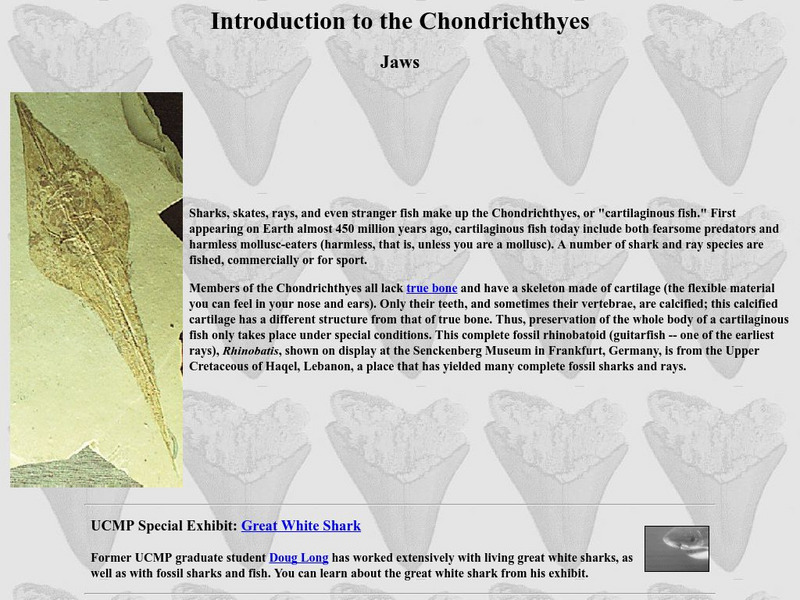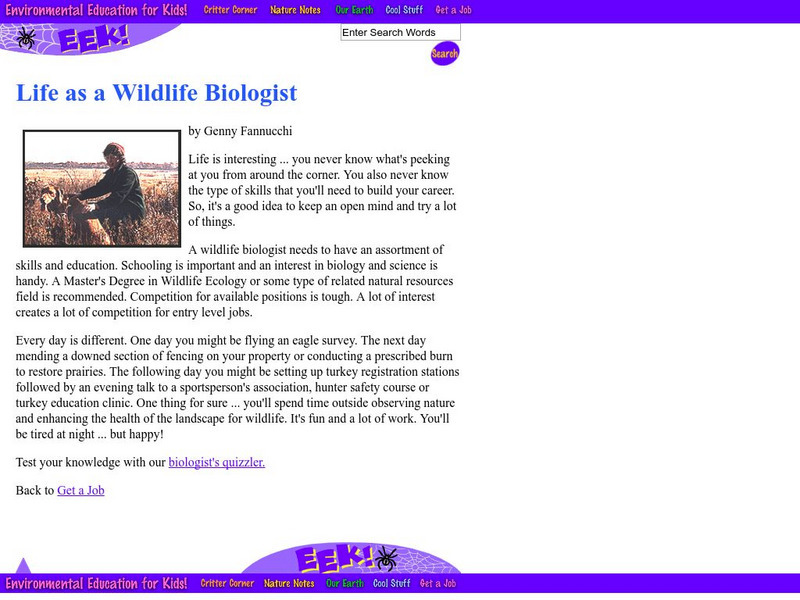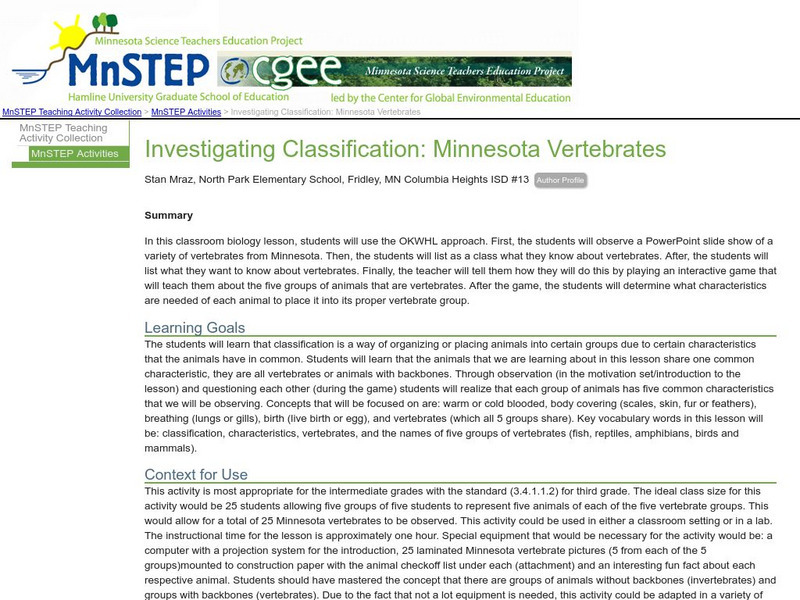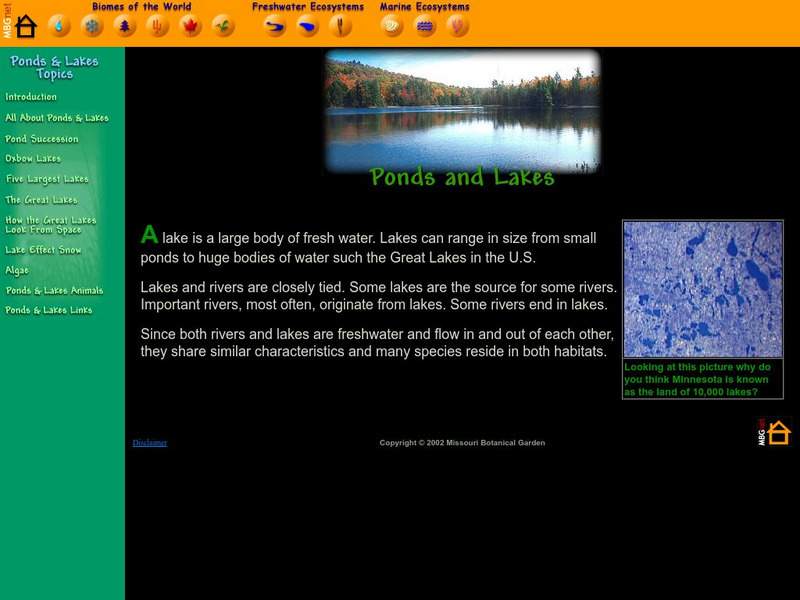Canadian Museum of Nature
Canadian Museum of Nature: Fish
Provides fascinating facts and colorful images of a variety of fish with a map of the location where they can be found.
E-learning for Kids
E Learning for Kids: Science: Caribbean Sea: How Can We Classify Animals?
Welcome to Hideaway Island where five pirates need to find crews for their ships. Join in and learn about animals with backbones.
Library of Congress
Loc: Poetry 180: It Took All My Energy
In this non-prose piece, the author reminisces about catching a fish, a symbolic event in the poet's life.
PBS
Pbs Learning Media: Breathing
Breathing shows an underwater scene and asks the students to answer the question, How do the people, fish and turtle get the oxygen they need?
PBS
Pbs Learning Media: Fish Behavior
Students are asked to explain the advantages of a fish participating in a school.
University of California
Ucmp: Introduction to Chondrichthyes
Good introduction from Berkeley's department of paleontology, gives a brief history and the defining characteristics of the class of Chondrichthyes.
University of Washington
Fish Scope: Fish Development
Provides photographs of the stages of fish development.
University of California
Ucmp: Myxini Hagfishes
This site contains quite a bit of information about hagfishes. There are pictures as well.
University of Guelph
Fish of Canada: Introduction to Fish
Great site that provides all types of information on fish ranging from fish ecology to funky fish. Entails links to sites on fish evolution and morphology.
Texas Instruments
Texas Instruments: Something's Fishy
In this activity, students examine the size, mass, and growth rates for three species of fish. They interpolate and extrapolate from best-fit models. Students compare the growth rates of endothermic and exothermic animals.
Environmental Education for Kids
Eek!: Life as a Wildlife Biologist
This site describes the skills needed for a career in Wildlife Biology. Includes link to a quiz that tests the student's knowledge of Wildlife issues.
Environmental Education for Kids
Eek!: Chemical Engineer
This site provides interesting and relevant information on engineering careers by offering a look into the life of a chemical engineer. Also, site describes what type of courses a student should study to pursue an engineering career.
Environmental Education for Kids
Eek!: Lake Superior
This site provides facts, illustrations, and more about the largest Great Lake. Includes descriptions of wildlife and industry. For grades 4-8.
Environmental Education for Kids
Eek!: Fish
Learn about various species of fish, including the bluegill, catfish and the largemouth bass.
Next.cc
Next: Aquaponics
Use these numerous activities to gain a better understanding of aquaponics, a gravity-based, closed loop system that grows both food and fish.
Science Education Resource Center at Carleton College
Serc: Investigating Classification: Minnesota Vertebrates
This lesson serves as an introduction to classification. The students will place animals into its proper vertebrate group according to certain characteristics that the animals have in common.
Sheppard Software
Sheppard Software: Pufferfish
This site gives an in-depth description of a pufferfish, including its behavior, appearance, and classification. The site includes photos and illustrations and an interactive quiz to test your understanding.
Missouri Botanical Garden
Missouri Botanical Garden: Freshwater Ecosystems
At this site from the Missouri Botanical Garden, you can learn about the wide variety of plant and animal life in or around fresh water ecosystems. Click on the links to "wetlands," "Ponds and Lakes," or "Rivers and Streams" to view...
Missouri Botanical Garden
Missouri Botanical Garden: Lakes and Ponds
This illustrated website features facts about lakes and ponds and their special place in geography, natural history, and as a biome.
American Institute of Biological Sciences
Action Bioscience: The Decline of North American Freshwater Fishes
An article addressing the need of immediate action to repair damages of declining life in the ecosystems of North American inland bodies of water.
Other
Alabama Division of Wildlife
Alabama Divion of Wildlife offers a comprehensive web site that includes, but is not limited to, game conservation.
BBC
Bbc: World's Smallest Fish
This article reports on the identification of a fish that has set a new record as the world's smallest known vertebrate.
abcteach
Abcteach: Animals
[Free Registration/Login Required] This link will place at your fingertips all kinds of resources for your science unit pertaining to animals such as birds, bugs, dinosaurs, endangered species, fish, mammals and reptiles.
TED Talks
Ted: Ted Ed: How Does a Jellyfish Sting?
Neosha S. Kashef details the science behind the jellyfish sting. [4:17]























